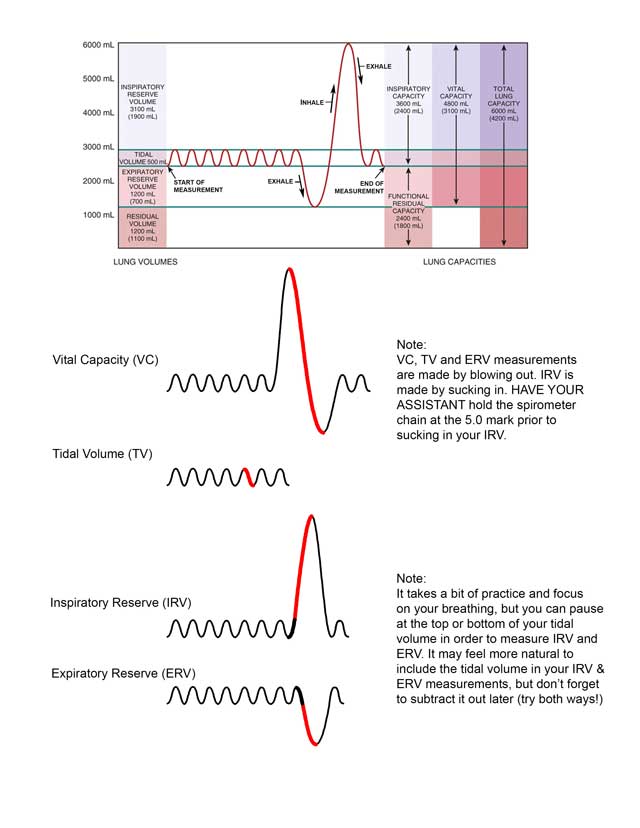Respiration Physiology Protocol
- Obtain a spirometer. Make sure the tank of the spirometer has been filled with water up to the full line.
- Obtain a cardboard mouthpiece from those provided and attach it to the end of the tube leading from the spirometer.
- Put the black pointer on the zero (0) mark of the scale.
- Measure your vital capacity. To do this, inhale as deeply as possible and then exhale as hard as you can into the mouthpiece. This will send air into the white bell of the spirometer and push the pointer across the scale. The point on the scale where the pointer is now resting is your vital capacity. Reset the pointer to 0 and repeat this measurement two more times so that you have 3 total measurements of vital capacity. Add these readings together and divide by 3 to get your average vital capacity. Record this number on the Respiratory Lab Worksheet.
- Measure your tidal volume. Tidal volume is the amount of air you inhale and exhale when breathing normally. To measure this, take a normal breath in and then exhale normally into the mouthpiece. Since your breathing is very shallow when at rest, the pointer should not move very much. Reset the pointer to 0 and repeat this measurement two more times so that you have 3 total measurements of tidal volume. Add these readings together and divide by 3 to get your average tidal volume. Record this number on the Respiratory Lab Worksheet.
- Measure your expiratory reserve. Expiratory reserve is the additional amount, beyond tidal, that you can exhale in one breath. To measure this, take a normal breath in, exhale normally, then try and exhale as much more as you can into the mouthpiece. Reset the pointer to 0 and repeat this measurement two more times so that you have 3 total measurements of expiratory reserve. Add these readings together and divide by 3 to get your average expiratory reserve. Record this number on the Respiratory Lab Worksheet.
- Measure your inspiratory reserve. Inspiratory reserve is the additional amount, beyond tidal, that you can inhale in one breath. To measure this, you will need a partner to help you. Manually raise the white bell until the pointer is at the 5.0 mark on the scale (since you are going to inhale in this measurement, the white bell must already have air in it and raising it accomplishes this). Have your partner place their finger on the chain so that the bell does not sink and the pointer remains at 5.0. When you are ready to begin your measurement, inhale normally and then try and inhale as much more as you can through the mouthpiece. When you start inhaling through the mouthpiece, your assistant must let go of the chain. When you finish inhaling, your assistant needs to put his/her finger back on the chain. Your inspiratory reserve is the difference between where you started (5.0) and where the pointer is now resting. Reset the pointer to 5.0 and repeat this measurement two more times so that you have 3 total measurements of inspiratory capacity. Add these readings together and divide by 3 to get your average inspiratory capacity. Record this number on the Respiratory Lab Worksheet.
- When you are finished, throw out your mouthpiece and allow the next person to use the spirometer.
- Using the data from your own measurements, perform the calculations described in the Respiratory Lab Worksheet to determine Inspiratory Capacity, Functional Residual Capacity and Total Capacity. In addition, record the height (in cm) and average vital capacity of each member of the class in Table 1 of the Respiratory Lab Worksheet and use this information to complete the worksheet.

